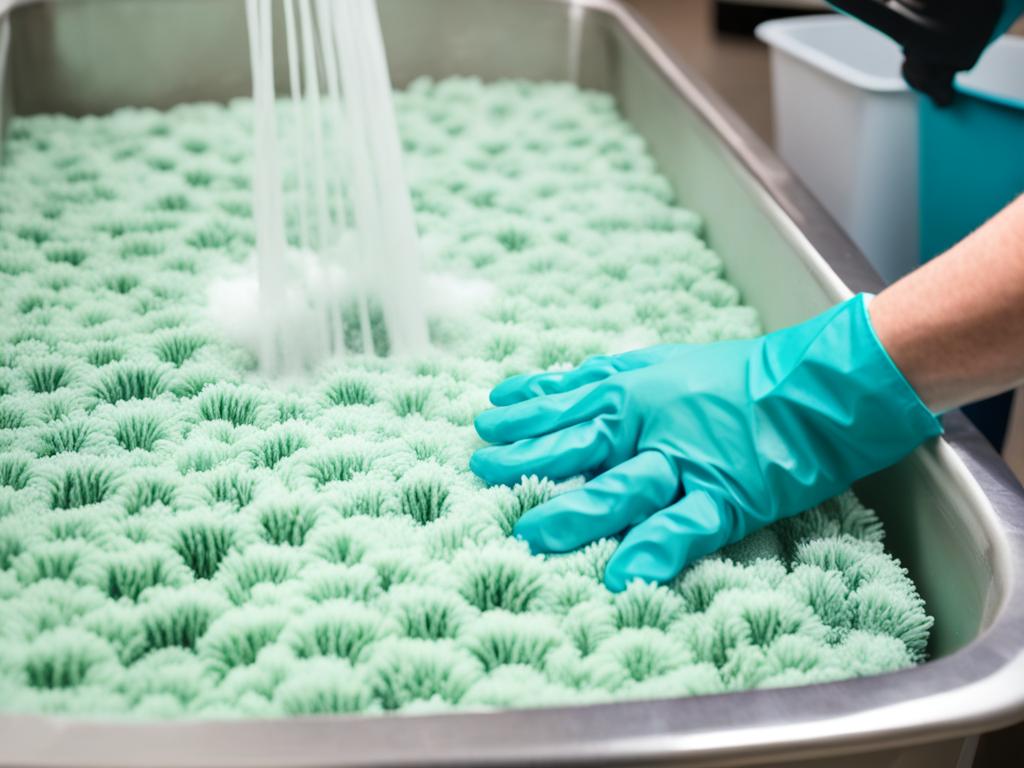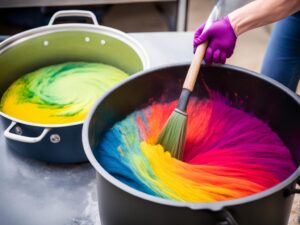Hooked rugs are unique and beautiful pieces of art that add warmth and character to any space. Whether you have a vintage heirloom or a newly crafted hooked rug, it’s important to know how to clean and maintain it properly. In this article, we will explore the best rug cleaning methods, tips for removing stains from hooked rugs, and how to deep clean your rug to ensure its longevity.
When it comes to cleaning hooked rugs, it’s crucial to follow specific guidelines to avoid damaging the fibers and maintain their beauty. Harsh detergents and chemicals should be avoided, and any surface stains should be blotted immediately with a dry white cloth. Instead of folding the rug, roll it lightly with the pile side out to prevent strain on the burlap foundation. To prevent damage from moisture, store the rug in a clean white cotton sheet in a dry area that is not prone to mold and mildew. Choosing a thin, non-sticky rug pad can also protect the rug from wear.
To remove dirt and debris from your hooked rug, use a gentle, non-aggressive vacuum or an upholstery attachment. It’s important to avoid using the beater-brush attachment as it can pull on the hooked fibers. When spot cleaning, use a soft baby hairbrush and a gentle detergent, testing it on a small, inconspicuous area first. For a deeper clean, hand-washing the rug with a wool soap can be effective, ensuring that you don’t agitate the fibers too much. After cleaning, always allow the rug to air dry on a clean surface.
Key Takeaways:
- Use a gentle, non-aggressive vacuum or upholstery attachment to clean hooked rugs.
- Spot clean surface stains immediately with a dry white cloth and a gentle detergent.
- Never fold a hooked rug; roll it lightly with the pile side out for storage.
- Choose a thin, non-sticky rug pad to protect the rug and prevent wear.
- To deep clean, hand-wash the rug with a wool soap and air dry on a clean surface.
Professional Rug Cleaning Tips
If you want your hooked rug to receive the best possible care and maintenance, it’s highly recommended to opt for professional cleaning. However, not all cleaners are equipped to handle delicate hand-made, antique, and heirloom textiles like hooked rugs. To ensure the longevity and preservation of your rug, it’s essential to choose a reputable cleaner who specializes in these types of rugs.
Regular dry cleaners may not have the necessary expertise and knowledge to handle the specific requirements of hooked rugs. Instead, consider reaching out to the textile departments of folk art museum collections for expert advice on cleaning and maintenance. These specialized institutions are well-versed in the proper care for various types of rugs and can guide you in finding the right solution.
Professional rug cleaners have access to specialized cleaning solutions that are safe for the delicate fibers of the rug. They also employ techniques that ensure a thorough and effective cleaning without causing any damage. By entrusting your hooked rug to a professional cleaner, you can rest assured that it will receive the best possible care.
Benefits of Professional Rug Cleaning
Here are some key benefits of opting for professional rug cleaning:
- Specialized cleaning solutions: Professional cleaners use solutions specifically formulated for different types of rugs, ensuring gentle but effective cleaning.
- Knowledge and expertise: Reputable rug cleaners have extensive knowledge and experience in handling diverse rug materials, designs, and construction techniques.
- Thorough cleaning: Professionals have the equipment and expertise to clean rugs thoroughly, removing deep-seated dirt, allergens, and stains.
- Preservation of rug quality: Proper cleaning methods employed by professionals help maintain the integrity and beauty of the rug.
- Damage prevention: Professional rug cleaners take precautions to prevent damage, such as color bleeding or shrinkage, during the cleaning process.
In addition to regular cleaning, professional assistance is particularly crucial if your hooked rug has significant damage, like rips or tears. Qualified restorers have the expertise to repair and restore the rug effectively, extending its lifespan and maintaining its value.
Remember, professional rug cleaning ensures a thorough and safe cleaning experience for your hooked rug, protecting its longevity and beauty.
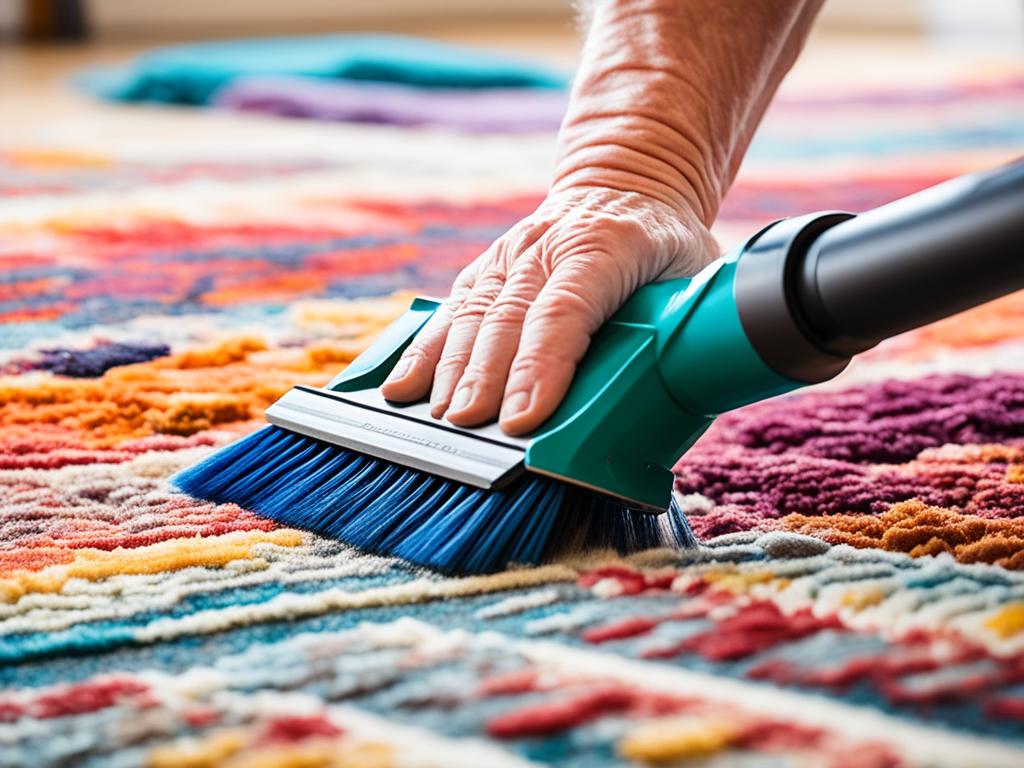
DIY Rug Cleaning Techniques
While professional rug cleaning is recommended for certain situations, there are DIY techniques you can use to maintain the cleanliness of your hooked rug.
- Vacuum Regularly: Regular vacuuming is important to remove grit and prevent it from wearing away at the fibers. Use a gentle hand-held vacuum, an upholstery attachment, or a floor attachment covered with cheesecloth to reduce suction force.
- Spot Clean Stains: Spot clean any stains immediately with a gentle detergent and a soft baby hairbrush. Test for colorfastness on the reverse side of the rug before applying any cleaning solution.
- Hand-Wash the Rug: For a more thorough cleaning, hand-wash the rug with a wool soap. Avoid agitating the fibers too much to prevent damage.
- Air Dry the Rug: Always air dry the rug on a clean surface to prevent mold and mildew. Avoid folding or storing the rug in areas prone to moisture.
Remember, when using DIY rug cleaning techniques, it’s important to be gentle and cautious to avoid causing any damage to the rug.
| Cleaning Technique | Instructions |
|---|---|
| Vacuuming | Use a hand-held vacuum, an upholstery attachment, or a floor attachment covered with cheesecloth to reduce suction force. Gently vacuum both sides of the rug to remove dirt and debris. |
| Spot Cleaning | Immediately blot up any spills or stains with a dry cloth. Mix a gentle detergent with warm water and apply it to the stain using a soft baby hairbrush. Blot the area with a clean cloth to remove the stain. Test the cleaning solution on a small, inconspicuous area of the rug first to ensure it doesn’t cause any damage. |
| Hand-Washing | Fill a basin or bathtub with cool water and add a gentle wool soap. Gently agitate the rug in the water, being careful not to twist or wring it. Rinse the rug thoroughly with cool water until there are no soap suds left. Squeeze out excess water gently, without wringing or twisting, and lay the rug flat on a clean surface to air dry. |
| Air Drying | Ensure the rug is completely dry before using or storing it. Lay it flat on a clean surface away from direct sunlight or heat sources. Avoid folding or storing the rug in humid areas to prevent mold and mildew. |
Regular maintenance using these DIY rug cleaning techniques will help keep your hooked rug looking its best.
Testimonials
“I’ve been using these DIY rug cleaning techniques for years, and they’ve saved me both time and money. My hooked rug always looks clean and fresh!” – Jane Smith
“I was skeptical at first, but after trying these DIY techniques, I was amazed at how effective they are. My rug looks brand new!” – Michael Johnson
With these tips and techniques, you can confidently maintain the cleanliness of your hooked rug and extend its lifespan.
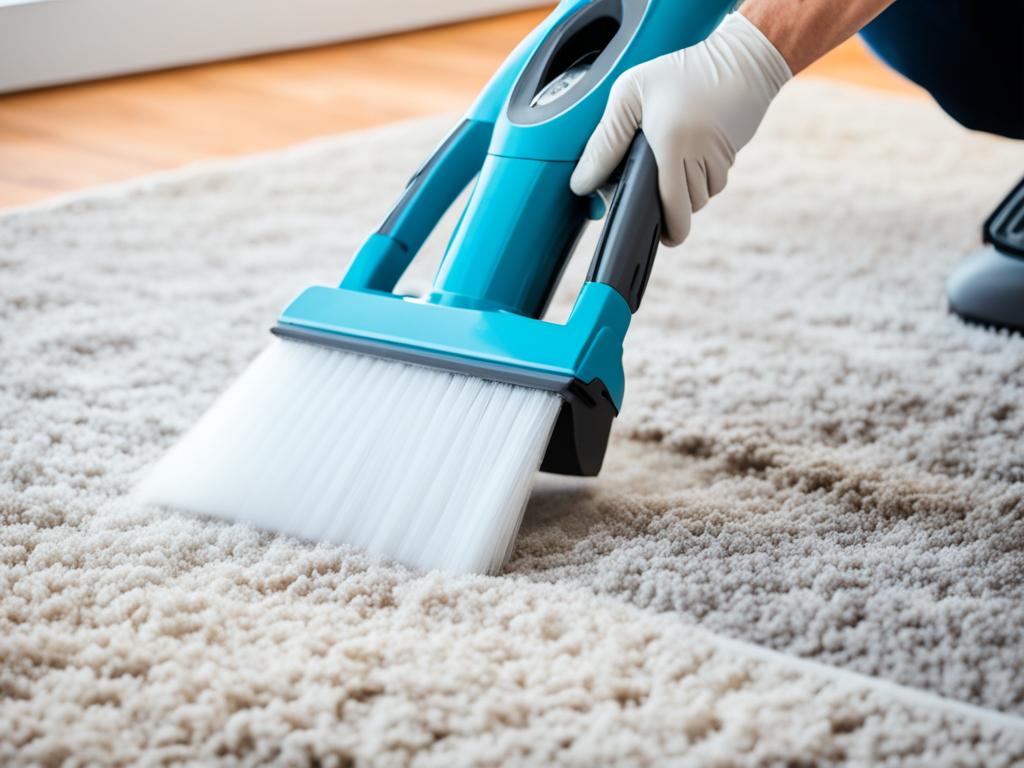
Repair and Restoration of Hooked Rugs
Over time, hooked rugs may require repair and restoration to maintain their beauty and functionality. Fortunately, there are several techniques that can be applied to fix common issues and breathe new life into these cherished pieces.
Re-hooking Snagged Yarn
If you notice a snagged yarn on your hooked rug, don’t worry. It can be easily repaired by following a simple process. Begin by pulling the unhooked yarn through to the back of the rug. Then, re-hook the yarn, securing it in place and restoring the rug’s original pattern.
Patching Chewed or Worn Areas
For more significant damage, such as a chewed or worn area, a patch can be an effective solution. Start by unhooking the damaged portion until you reach healthy backing. Next, sew in a patch, making sure to tack the layers of backing together securely. With the patch in place, re-hook the rug, ensuring that the hooks go through both layers for a strong and seamless repair.
Adding Bound Edges for Protection
To prevent further damage to the edges of your hooked rug, consider adding bound edges. This can help reinforce the rug and protect it from unraveling. Choose a matching yarn and whip stitch over cording, creating a durable and attractive finish that will prolong the life of the rug.
Seeking Professional Assistance
While many repairs can be tackled as DIY projects, extensive damage or intricate restorations may require the expertise of a qualified restorer. These professionals have the knowledge and skills to assess the condition of the rug and execute delicate repairs with precision. If you feel that your rug needs significant repair or restoration, it is highly recommended to consult a professional in order to achieve the best results.
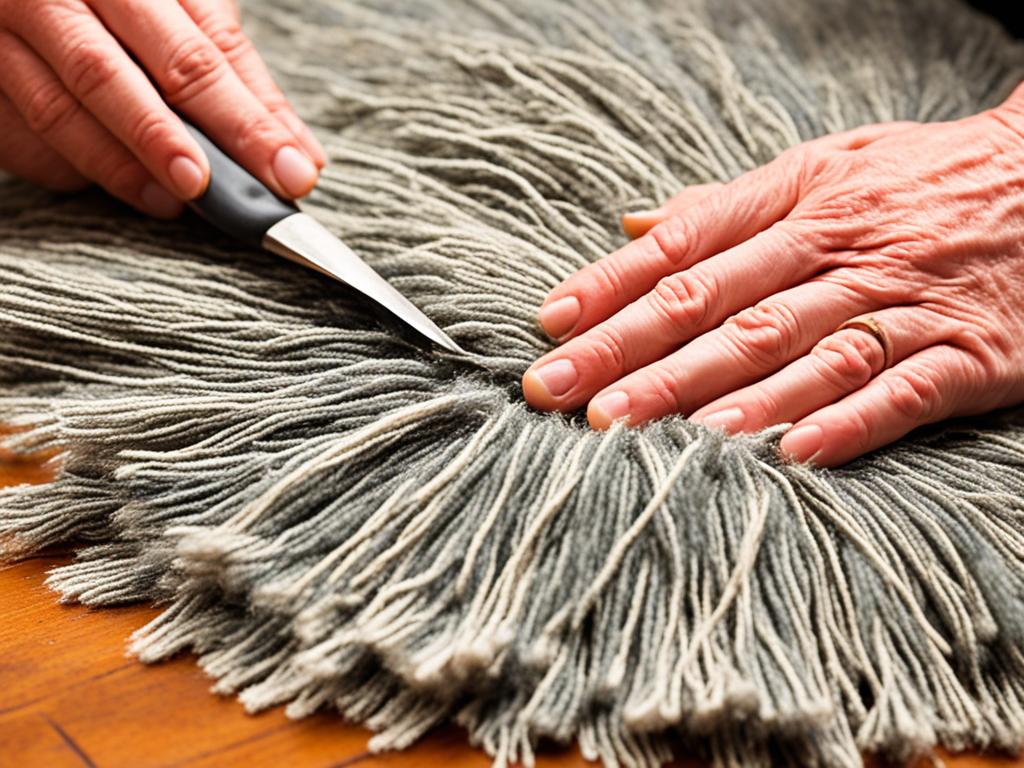
Remember, the repair and restoration of hooked rugs is an art form that requires patience and attention to detail. By properly addressing issues and seeking professional assistance when needed, you can ensure that your hooked rugs retain their beauty and functionality for generations to come.
| Common Rug Repair Techniques | Description |
|---|---|
| Re-hooking Snagged Yarn | Pulling unhooked yarn through to the back and re-hooking it |
| Patching Chewed or Worn Areas | Unhooking damaged portion, sewing in a patch, and re-hooking the rug |
| Adding Bound Edges | Whip stitching a matching yarn over cording to reinforce and protect the edges |
| Seeking Professional Assistance | Consulting a qualified restorer for extensive repairs or delicate restorations |
Conclusion
Proper maintenance and cleaning techniques are crucial for preserving the beauty and longevity of your hooked rug. By following a few best practices, you can ensure that your rug remains in pristine condition for years to come. Regular vacuuming is essential to remove dirt and debris that can accumulate on the surface. Use a gentle hand-held vacuum or an upholstery attachment to prevent damage to the delicate fibers.
For spot cleaning, it’s important to act quickly and blot up any spills or stains with a dry white cloth. Avoid using harsh chemicals and detergents, as they can damage the rug. Instead, opt for a mild detergent and gently clean the affected area using a soft baby hairbrush. If a more thorough cleaning is required, hand-washing with a wool soap can be effective, but be cautious not to agitate the fibers too much.
While DIY techniques can help maintain the cleanliness of your rug, it’s advisable to seek professional rug cleaning for deeper cleaning and significant damage. Professional cleaners have the expertise and specialized cleaning solutions to properly care for your hooked rug. Additionally, if your rug requires repair and restoration, it is best to rely on the skills of a qualified restorer who can expertly mend any damage.
By following these maintenance practices, seeking professional assistance when needed, and taking prompt action to address spills and stains, you can ensure that your hooked rug retains its beauty and integrity. With proper care, your rug will continue to be a cherished part of your home decor for generations to come.
